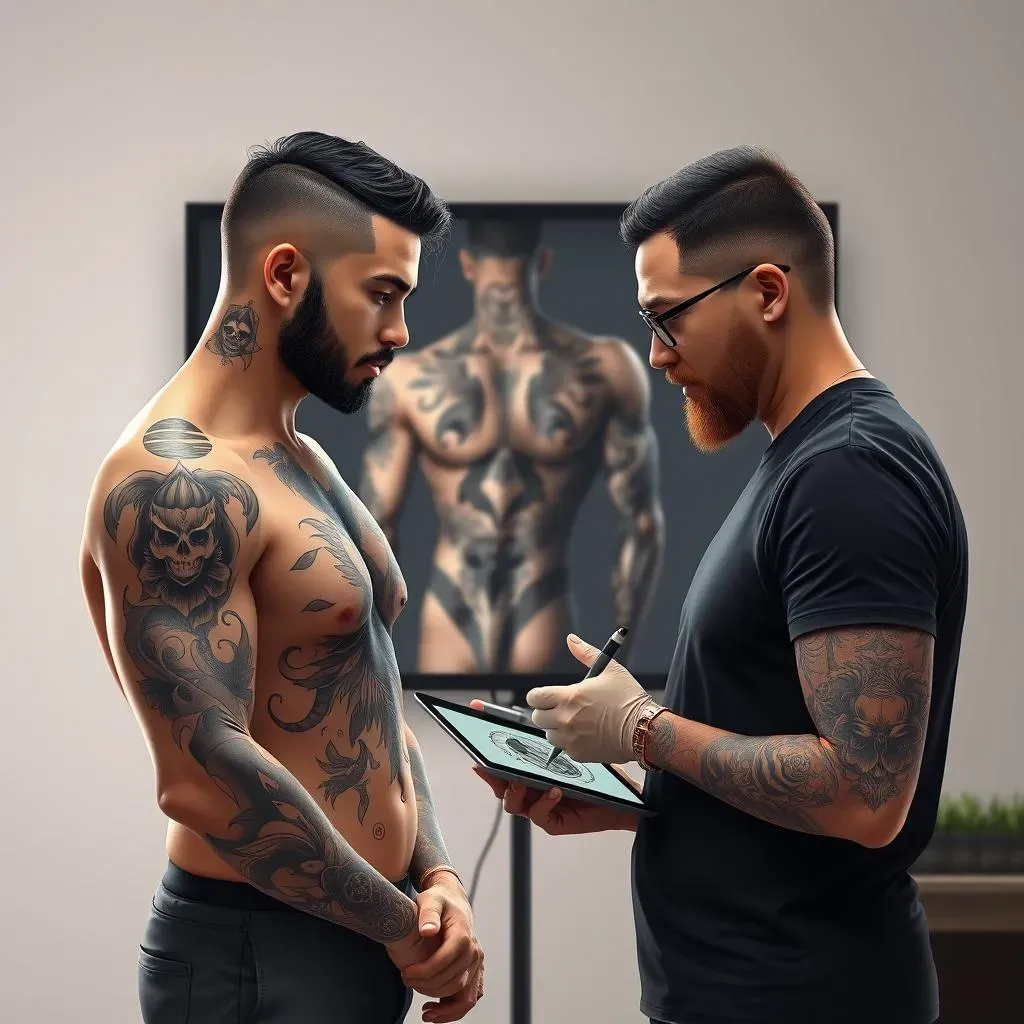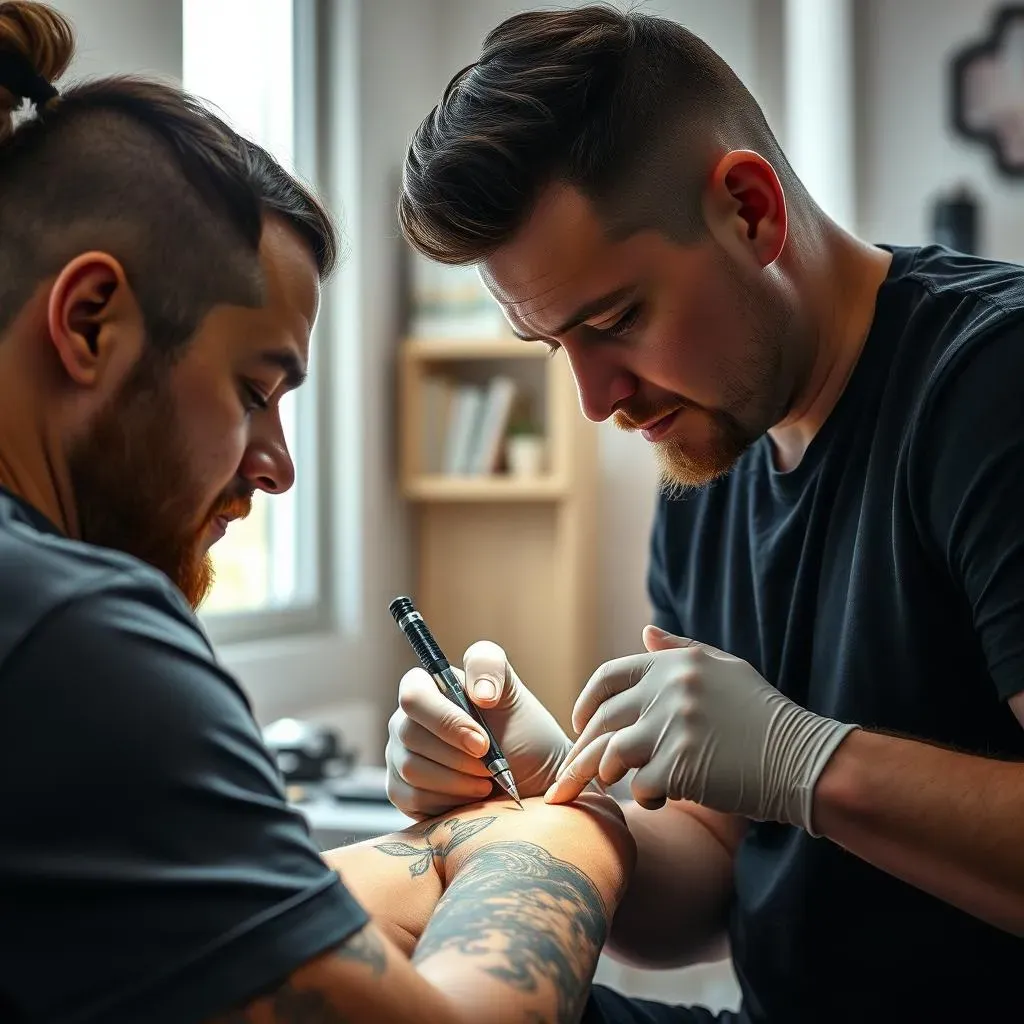Table of Contents
So, you're thinking about getting a small tattoo? Awesome! But before you jump into the chair, there's a crucial question: where should a small tattoo be placed on a woman? It's not just about picking a pretty design; it's about finding the perfect spot on your body that complements the art and your personal style. Think of it like choosing the right frame for a painting – it can make all the difference. This isn't about a one-size-fits-all answer, because what works for one person might not work for another. We'll explore the key things to think about, from the shape of your body to your pain tolerance, and even how visible you want your new ink to be. We'll look at some popular choices, like wrists, ankles, and ribs, and why they might be a good fit. Plus, we'll chat about how your tattoo artist can be your best ally in this process. Get ready to discover the best place for your little piece of art.
Factors to Consider When Choosing a Small Tattoo Placement for Women

Factors to Consider When Choosing a Small Tattoo Placement for Women
Body Shape and Tattoo Flow
first things first, let's talk about your body's natural curves and lines. A tattoo should feel like it belongs there, like it's a part of you, not just something stuck on. Think about how the placement will flow with your body's shape. For example, a small, delicate floral design might look amazing wrapping around your wrist, following its natural curve. But the same tattoo might look awkward and out of place on your lower back. So, it's like picking the right frame for a picture, you wouldn't put a landscape photo in a tiny square frame, would you?
Consider areas where your skin naturally moves and stretches. A tattoo placed on a spot where your skin folds might look distorted or blur over time. It's like trying to paint on a balloon – it looks great when it's inflated, but once the air goes out, it's all wonky. So, think about how your body moves and what parts of your skin are stable.
Pain Tolerance and Sensitivity
Alright, let's get real for a second. Some spots hurt way more than others when getting a tattoo. Areas with lots of nerve endings, like your ribs, feet, and fingers, can be pretty intense. Think of it like stubbing your toe, but for a longer period, and with a needle. On the other hand, places with more muscle or fat, like your outer thigh or upper arm, tend to be less painful. It's like the difference between a tap and a punch – one is definitely more uncomfortable. If you're a little nervous about pain, maybe start with a less sensitive area. You can always get more tattoos later, right?
Tattoo Placement | Pain Level (Low to High) |
|---|---|
Outer Thigh | Low |
Upper Arm | Low to Medium |
Wrist | Medium |
Ankle | Medium |
Ribs | High |
Fingers | High |
Feet | High |
Visibility and Professional Considerations
Now, let's think about how visible you want your tattoo to be. If you work in a professional setting, you might want to choose a spot that can be easily covered up, like your ribs or upper thigh. It's like having a secret superpower – it's there if you want it to be seen, but you can also keep it hidden if you need to. On the flip side, if you're all about showing off your ink, a wrist or ankle tattoo is a great choice. It's like wearing a piece of art on your sleeve, or your ankle in this case, literally. Think about your lifestyle and where you see yourself in the future. You don’t want your tattoo to be a barrier to your goals.
Also, consider how your tattoo might look in different social situations. Will you feel comfortable showing it off at family gatherings? What about at the beach? It's like choosing an outfit, you want it to be appropriate for the occasion. It’s all about finding that sweet spot between self-expression and practicality.
Popular Small Tattoo Placement Ideas for Women

Popular Small Tattoo Placement Ideas for Women
Wrist Tattoos: Delicate and Visible
Let's kick things off with the wrist, a classic spot for a reason. It's like wearing a permanent bracelet, always on display. Small designs, like a single word, a tiny symbol, or a delicate line, look amazing here. It's a place that's both subtle and noticeable, depending on how you move your hands. I've seen everything from tiny hearts to minimalist geometric shapes on wrists, and they always look so chic. It's also a good spot if you want to glance down and see your tattoo, a little reminder throughout the day.
One of my friends has a tiny semicolon on her wrist, a symbol of hope and resilience. It's small, but it carries a big meaning. And that's the beauty of wrist tattoos, they can be a little secret message or a bold statement, all in a small package. Plus, if you need to hide it, a long sleeve is all it takes. So, it's pretty versatile.
Ankle Tattoos: Subtle and Charming
Next up, let's talk ankles. This is another fantastic spot for small tattoos, offering a touch of charm and subtlety. It's like wearing a little anklet, but way cooler. Think tiny stars, feathers, or delicate flowers that wrap around your ankle bone. Ankle tattoos are perfect if you want something that's visible when you want it to be, but easily hidden under socks or shoes. It's a bit like a hidden gem, a little secret that you can show off when you feel like it. I personally love how they add a touch of personality to any outfit.
A friend of mine has a tiny wave on her ankle, a reminder of her love for the ocean. It’s so simple, yet it tells a story. Ankle tattoos are great for those little designs that have personal meaning, and they always look so good with sandals or bare feet. They are a great place to start if you are not sure about getting a tattoo.
Placement | Style | Visibility |
|---|---|---|
Wrist | Delicate, Minimalist | High, Easily Visible |
Ankle | Charming, Subtle | Medium, Can be Hidden |
Ribs | Personal, Hidden | Low, Easily Concealed |
Rib Tattoos: Personal and Hidden
Finally, let's explore rib tattoos. This is a more personal spot, often chosen for designs that hold a special meaning. It's like having a secret message close to your heart. Small, meaningful quotes, intricate patterns, or delicate floral designs look incredible on the ribs. They are a bit more hidden, so they’re perfect for those who want a tattoo that’s just for them, or for those who need to keep it covered for work. It’s a great spot for a tattoo that you can show off when you want, but keep private when you need to.
I have a friend who has a tiny constellation on her ribs, each star representing a loved one. It's a beautiful, personal tribute that she can carry with her always. Rib tattoos are often a little more painful because of the location, but many people say the meaningfulness of the design makes it worth it. They are a great way to express yourself without being too in your face. It is also a great spot that allows the tattoo to flow with your body.
How Tattoo Artists Can Help with Placement Decisions

How Tattoo Artists Can Help with Placement Decisions
Expert Advice on Body Flow
so you've got a cool design in mind, but you're not quite sure where it should live on your body? This is where your tattoo artist becomes your best friend. They're not just there to ink you; they're also experts in how tattoos look on different body parts. They can see how your design will flow with your muscles, curves, and natural lines. It's like having a personal stylist for your skin. They can tell you if a design will look awesome on your ankle or if it might be a bit wonky on your ribs. They've seen it all, trust me. It's like they have a secret map of the body and how tattoos should travel on it.
They'll take into consideration things you might not even think about, like how the tattoo will look when you move, how it will age over time, and even how it will look in different lighting. It's not just about slapping a design on your skin; it's about creating a piece of art that works with your body. They're like the architects of your skin, making sure everything is in the right place and looks just right. So don't hesitate to ask for their opinion, they're there to help you get the best result.
Artist's Role | Benefit |
|---|---|
Body Flow Expertise | Ensures tattoo complements body's shape |
Aging and Movement Assessment | Predicts how tattoo will look over time |
Personalized Advice | Tailors placement to your body and design |
Considering Size and Proportion
Another area where tattoo artists really shine is in helping you figure out the right size for your tattoo, based on where you want to place it. A tiny tattoo might get lost on a large area of your body, while a large tattoo might feel overwhelming on a smaller spot. It's like picking the right size of furniture for your room – too big or too small and it throws everything off. Your tattoo artist can help you scale the design so it looks just right on your chosen location. They can help you visualize how it will look and make sure that it’s proportionate to your body.
They’ll also consider the negative space around the tattoo. It's like framing a picture, the empty space around the design is just as important as the design itself. It can help make the tattoo stand out and look even better. It is something that a tattoo artist will help you to make sure it is done right. They have a keen eye for detail and they know how to make your tattoo look its absolute best. So, listen to their advice, they know what they are talking about.
- Size and scale suggestions
- Negative space considerations
- Ensuring proper proportions
Designing for different body parts

Designing for different body parts
Adapting Designs to Body Contours
Alright, let's get into the nitty-gritty of designing tattoos for different body parts. It's not just about shrinking or enlarging a design; it's about making it work with the unique landscape of your body. Think of it like tailoring a suit – you wouldn't use the same pattern for a jacket as you would for pants, right? Similarly, a design that looks fantastic on a flat surface might not translate well to a curved area like your shoulder or ankle. You need to consider how the design will wrap, bend, and flow with the body's natural contours. For example, a long, flowing design might look great on a forearm, but the same design might look cramped and awkward on a wrist. It's all about understanding how the body's shape will affect the tattoo's appearance.
When designing for a specific body part, you also need to think about the visual impact. A design that's too small might get lost on a larger area, while a design that's too large might look overwhelming on a smaller area. It's like choosing the right size of a picture for a wall, you want it to be proportionate. For example, a tiny, intricate design might look amazing on a wrist, but it might not be as impactful on a larger area like the back. You need to consider the overall balance and how the tattoo will look in relation to the rest of your body. It's like creating a piece of art that's designed to be worn, not just looked at.
Choosing the Right Elements for Each Area
Now, let's talk about the specific elements that work best for different body parts. When designing for wrists and ankles, delicate lines, small symbols, and simple shapes are often the way to go. These areas are smaller and more delicate, so a complex design might look cluttered. It's like choosing the right type of jewelry – a bold, chunky necklace might not look as good with a delicate dress as a simple pendant. When designing for areas like the ribs or upper arms, you have more room to play with larger designs, intricate patterns, and meaningful quotes. These areas can handle more detail and complexity, allowing you to create a more impactful piece of art. It's like choosing the right canvas for a painting – a small canvas is better for a small, simple design, while a larger canvas is better for a larger, more complex design.
Also, consider the direction of the design. A design that flows with the natural lines of the body will look more harmonious and balanced. For example, a design that wraps around the arm or leg will look more natural than a design that sits awkwardly on top of the skin. It's like choosing the right direction for a pattern on fabric, it should flow with the shape of the garment. Ultimately, the key is to choose elements that complement the specific body part and create a cohesive, visually appealing tattoo. It's like creating a piece of art that's designed to be worn, not just looked at, so make sure that it flows and fits perfectly.
Body Part | Ideal Design Elements | Considerations |
|---|---|---|
Wrists/Ankles | Delicate lines, small symbols, simple shapes | Smaller area, delicate nature |
Ribs/Upper Arms | Larger designs, intricate patterns, quotes | More space, can handle complexity |
Forearms | Flowing designs, linear patterns | Good for linear designs, visible area |
Considering Pain, Visibility and Future Plans

Considering Pain, Visibility and Future Plans
Pain Tolerance Revisited for Placement
so we touched on pain before, but let's really think about it now that we're getting down to the nitty-gritty of placement. It's not just about whether you can handle the needle; it's about how the pain might affect your overall experience. A tattoo session can take a while, and if you're in agony for hours, it's not going to be a pleasant time. Some people can handle the pain like a champ, but if you’re someone who winces at a paper cut, you might want to avoid the super sensitive areas. It's like running a marathon – you wouldn't start with a sprint, right? Start with a spot that won't make you want to tap out before it's even done. It is all about having a good experience.
Think about the size of the tattoo too. A small tattoo on a painful area might be bearable, but a larger piece on the same spot could be a real challenge. It's like the difference between a quick pinch and a long, drawn-out squeeze. It’s important to be realistic about your pain tolerance and pick a spot that you can handle. It's also okay to start with a less painful spot and work your way up. You don't have to prove anything to anyone. Remember, it's your body and your experience, so make sure it is a good one. Don’t be a hero, be smart.
Pain Level | Body Areas | Considerations |
|---|---|---|
Low | Outer Thigh, Upper Arm | Good for beginners, longer sessions |
Medium | Wrist, Ankle | Manageable for most, moderate sessions |
High | Ribs, Fingers, Feet | May require breaks, shorter sessions |
Visibility: Now and Later
We’ve talked about how visible you want your tattoo now, but what about in the future? Will your current job always be your career? Will your style change? These are important questions to ask. A tattoo on your hand might be awesome now, but what if you decide to become a lawyer? It's like picking a hairstyle – you want something that you'll still love next year. Think about your long-term goals and how your tattoo might fit into them. It is okay to want to change, but your tattoo will be there with you, so make sure it is something that you will not regret.
Also, think about how your tattoo will look as you age. Skin stretches and changes over time, and this can affect the appearance of your tattoo. A tattoo that looks crisp and clear now might look a bit blurry or distorted in the future. It’s like an old photograph – it might not be as sharp as it once was. So, consider how your body might change and choose a spot that will age well. It’s not about being afraid of change, it’s about being prepared for it. It's about choosing a placement that will look good on you now and in the future. After all, a tattoo is for life.
"The best way to predict the future is to create it." - Peter Drucker
The Artist's Role in Tattoo Placement Advice

The Artist's Role in Tattoo Placement Advice
The Artist as a Body Art Expert
So, you've got a design, you've got an idea of where you want it, but you're still a bit unsure? That's totally normal, and it's where your tattoo artist steps in as a true body art expert. They're not just there to follow your instructions; they're there to help you make the best decision for your body and your vision. Think of them as a sculptor who knows exactly how a piece will look on different canvases. They've seen countless tattoos on countless bodies, so they have a wealth of experience to draw from. They can guide you on how a design will flow with your muscles, curves, and overall body shape. It's like having a personal art consultant for your skin. They’re going to help you get the best result.
Your tattoo artist can also help you consider how the tattoo will look over time. They know how different areas of the body stretch and change, and they can help you choose a placement that will age well. It's like picking a quality piece of furniture – you want it to look good for years to come. They'll consider things like how your skin moves, how the ink will settle, and even how different lighting will affect the tattoo's appearance. It's not just about the immediate result; it's about creating a piece of art that will stand the test of time. They’ll make sure your tattoo looks great now and in the future.
Artist's Expertise | Benefit to You |
|---|---|
Body Shape Knowledge | Ensures tattoo complements your form |
Aging Considerations | Helps choose placement that will age well |
Experience with Different Designs | Provides insights on design suitability for various areas |
Personalized Placement Recommendations
One of the best things about working with a good tattoo artist is that they can provide personalized recommendations based on your unique body and design. They're not going to give you a generic answer; they're going to take the time to understand your vision and help you find the perfect placement. It's like having a custom-tailored suit – it's made just for you. They'll look at the size and shape of your design, your pain tolerance, your lifestyle, and your personal preferences. They'll consider all the factors that we've discussed and then they'll give you their expert opinion. It’s like getting a second opinion from someone who knows what they are talking about.
They might even suggest a placement that you hadn't even considered, and that ends up being perfect for you. They'll show you how the design will look on different areas of your body, and they'll help you visualize the final result. It's like getting a sneak peek into the future. They’ll help you make an informed decision that you feel comfortable and confident with. It's not about them telling you what to do; it's about them guiding you to find the best option for you. They are your ally in the tattoo journey, so make sure to listen to them.
The Importance of Open Communication
Ultimately, the key to a successful tattoo placement is open communication with your artist. Don't be afraid to ask questions, express your concerns, and share your vision. It's your body, and you should feel comfortable and excited about the tattoo you are getting. Your tattoo artist is not a mind reader; they need to know what you are thinking. It's like a partnership – you're working together to create a piece of art that you'll love for years to come. The more information you provide, the better they can help you.
And remember, it's okay to change your mind. If you're not feeling 100% confident about a placement, it’s better to speak up and explore other options. Don't feel pressured to make a decision if you're not ready. It's like choosing a life partner – you want to make sure it's the right fit. A good tattoo artist will understand this, and they'll be happy to work with you until you find the perfect placement. It's all about making sure you're happy with the final result. It's a team effort and you need to be on the same page to make it work.
"The only way to do great work is to love what you do." - Steve Jobs
Resources for Tattoo Placement Learning

Resources for Tattoo Placement Learning
so you're getting serious about tattoo placement, that's awesome! You've thought about body shapes, pain, and visibility, and you've even chatted with your artist. But what if you want to go even deeper? Well, there's a whole world of resources out there to help you become a tattoo placement pro. We're talking apps, online libraries, and even good old-fashioned books. It's like going from a casual fan to a true expert in the art of tattoos. It's all about soaking up as much knowledge as you can, so you can make the best decisions for your body and your designs. The more you know, the more confident you’ll be. Think of it like leveling up in a game; the more you learn, the better you become.
First up, let's talk about apps. There are some pretty cool ones out there that let you visualize how a tattoo would look on your body. You can upload a photo of yourself and try out different designs and placements. It's like trying on clothes before you buy them, but for tattoos. Some apps even have augmented reality features, so you can see the tattoo in real-time as you move around. It’s a super cool way to experiment and get a feel for what works best. It's like having a virtual tattoo studio right in your pocket. You can play around with different options, see what catches your eye and what doesn't, all before you even step into the studio. It's a game-changer for planning your next piece of ink.
Resource | Description | Benefit |
|---|---|---|
Tattoo Placement Apps | Virtual try-on tools | Visualizing designs on your body |
Online Tattoo Libraries | Extensive galleries of designs | Inspiration and design ideas |
Tattoo Books and Magazines | In-depth articles and artist interviews | Understanding industry and placement principles |
Next, there are tons of online libraries and galleries where you can find endless inspiration. You can browse through thousands of designs and see how they look on different body parts. It's like having a giant catalog of tattoos at your fingertips. You can also find articles and blog posts that talk about the pros and cons of different placements. It's like getting advice from a whole community of tattoo enthusiasts. It is a great way to see what works and what doesn't, and to get a sense of what you like. It’s like having a never-ending source of inspiration to fuel your tattoo dreams. You can spend hours just browsing and getting ideas, and that is half the fun of it.
And don't forget about the classics, like books and magazines. There are some amazing publications that cover everything from tattoo history to artist interviews and detailed guides on placement. It's like taking a deep dive into the world of tattoos. You can learn about the different styles, techniques, and principles behind good placement. It's like going to tattoo school, but in the comfort of your own home. It’s a great way to get a more in-depth understanding of the art and science of tattoo placement. It’s like having a personal mentor guide you through the world of ink.
Wrapping Up: Finding Your Perfect Tattoo Spot
Choosing where to place a small tattoo is a personal journey, and there's no single right answer. It's about balancing what looks good with what feels right for you. Think about how the tattoo will flow with your body, how much you want it to show, and how it fits with your lifestyle. Don't be afraid to chat with your tattoo artist; they’ve seen it all and can offer invaluable advice. Ultimately, the best placement is the one that makes you happy and proud to show off your new art. So take your time, explore your options, and get ready to rock that ink!